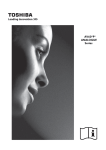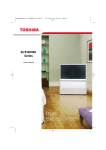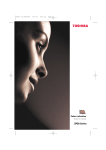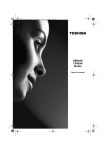Download Toshiba AV500/42 User's Manual
Transcript
00GB_AV500P_EngOM.book Page 1 Tuesday, December 11, 2007 5:40 AM AV50* Series 00GB_AV500P_EngOM.book Page 2 Tuesday, December 11, 2007 5:40 AM 00GB_AV500P_EngOM.book Page 3 Tuesday, December 11, 2007 5:40 AM Contents SETTING UP TEXT SERVICES Safety Precautions ..................................................4 Installation and important information ....................5 The remote control .................................................6 Inserting batteries and effective range of the remote ..........................................................6 Connecting external equipment ..............................7 Connecting an HDMI™ or DVI device to the HDMI input ...................................................................8 To connect an HDMI device ..............................8 To connect a DVI device ...................................8 Connecting a computer ..........................................9 To connect a PC to the HDMI terminal ..............9 Using the controls ................................................10 Switching on ..................................................10 Using the remote control ...............................10 Using the controls ..........................................10 Text services ......................................................... 25 Selecting modes ............................................ 25 Text information ............................................ 25 Navigating pages using Auto ......................... 25 Navigating pages using LIST .......................... 25 Control buttons ............................................. 26 PROBLEM SOLVING Questions and Answers ........................................ 27 INFORMATION Notes ................................................................... 29 Specifications and accessories .............................. 30 TUNING THE TELEVISION Tuning the television ............................................11 Quick Setup ...................................................11 Manual tune ..................................................12 Programme skip ............................................13 Using Auto tuning ..........................................14 CONTROLS AND FEATURES General controls ...................................................15 Selecting programme positions ......................15 The Time Display ...........................................15 Stereo and Bilingual transmissions .................15 Sound controls .....................................................15 Volume controls and mute sound ...................15 Bass, Treble and Balance ...............................15 Bass boost .....................................................15 Dual ..............................................................15 Widescreen viewing ..............................................16 Picture controls .....................................................18 Picture position ..............................................18 Backlight .......................................................18 Picture preferences ........................................19 Black stretch ..................................................19 MPEG NR – Noise Reduction ..........................19 DNR – Digital Noise Reduction .......................19 Colour temperature .......................................19 Colour management ......................................20 Base colour adjustment ..................................20 Active backlight control ..................................20 Cinema mode ................................................20 Automatic format (Widescreen) ......................21 Blue screen ....................................................21 Side panel adjustment ...................................21 Picture still .....................................................21 Panel lock ............................................................22 Sleep timer ...........................................................22 Input selection and AV connections .......................23 Input selection ...............................................23 INPUT signal selection ...................................23 HDMI1 audio .................................................24 3 00GB_AV500P_EngOM.book Page 4 Tuesday, December 11, 2007 5:40 AM SETTING UP Safety Precautions DO NOT REMOVE ANY FIXED COVERS AS THIS WILL EXPOSE DANGEROUS AND 'LIVE' PARTS. This equipment has been designed and manufactured to meet international safety standards but, like any electrical equipment, care must be taken to obtain the best results and for safety to be assured. Please read the points below for your own safety. They are of a general nature, intended to help with all electronic consumer products and some points may not apply to the goods you have just purchased. THE MAINS PLUG IS USED AS A DISCONNECTING DEVICE AND THEREFORE SHOULD BE READILY OPERABLE. Do not DO NOT obstruct the ventilation openings of the Air Circulation equipment with items such as newspapers, tablecloths, curtains, etc. Overheating will cause damage and shorten the life of the equipment. Leave more than 10cm clearance around the television to allow adequate ventilation. This will prevent overheating and possible damage to the television. Dusty places should also be avoided. DO NOT allow electrical equipment to be exposed to dripping or splashing or objects filled with liquids, such as vases, to be placed on the equipment. DO NOT place hot objects or naked flame sources, such as lighted candles or nightlights on, or close to equipment. High temperatures can melt plastic and lead to fires. Heat Damage Damage may occur if the television is left in direct sunlight or near a heater. Avoid places subject to extremely high temperatures or humidity. Place in a location where the temperature remains between 5°C (41°F) min. and 35°C (94°F) max. DO NOT use makeshift stands and NEVER fix legs with wood screws. To ensure complete safety, always fit the manufacturers’ approved stand, bracket or legs with the fixings provided according to the instructions. DO NOT leave equipment switched on when it is unattended, unless it is specifically stated that it is designed for unattended operation or has a standby mode. Switch off by withdrawing the plug, make sure your family know how to do this. Special arrangements may need to be made for people with disabilities. Mains Supply The mains supply required for this equipment is 220240v AC 50/60Hz. Never connect to a DC supply or any other power source. DO ensure that the television is not standing on the mains lead. DO NOT cut off the mains plug from this equipment, this incorporates a special Radio Interference Filter, the removal of which will impair its performance. In the UK, the fuse fitted in this plug is approved by ASTA or BSI to BS1362. It should only be replaced by a correctly rated and approved type and the fuse cover must be refitted. IF IN DOUBT PLEASE CONSULT A COMPETENT ELECTRICIAN. DO NOT continue to operate the equipment if you are in any doubt about it working normally, or it is damaged in any way – switch off, withdraw the mains plug and consult your dealer. WARNING – excessive sound pressure from earphones or headphones can cause hearing loss. ABOVE ALL – NEVER let anyone, especially children, push or hit the screen, push anything into holes, slots or any other openings in the case. NEVER guess or take chances with electrical equipment of any kind – it is better to be safe than sorry. Do DO read the operating instructions before you attempt to use the equipment. DO ensure that all electrical connections (including the mains plug, extension leads and inter-connections between pieces of equipment) are properly made and in accordance with the manufacturers’ instructions. Switch off and withdraw the mains plug before making or changing connections. DO consult your dealer if you are ever in doubt about the installation, operation or safety of your equipment. DO be careful with glass panels or doors on equipment. 4 00GB_AV500P_EngOM.book Page 5 Tuesday, December 11, 2007 5:40 AM SETTING UP Installation and important information Where to install Locate the television away from direct sunlight and strong lights, soft, indirect lighting is recommended for comfortable viewing. Use curtains or blinds to prevent direct sunlight falling on the screen. Sturdy tie (as short as possible) Place on a sturdy platform, the mounting surface should be flat and steady. It should be secured to the wall with a sturdy tie using the clip on the back of the stand, or secured to the platform using the fixing strap located underneath the table top stand, this will prevent it from falling over. Clip Clip The LCD display panels are manufactured using an extremely high level of precision technology, however sometimes some parts of the screen may be missing picture elements or have luminous spots. This is not a sign of a malfunction. Side View Clip Top View Make sure the television is located in a position where it cannot be pushed or hit by objects, as pressure will break or damage the screen, and that small items cannot be inserted into slots or openings in the case. Please take note EXCLUSION CLAUSE Toshiba shall under no circumstances be liable for loss and/or damage to the product caused by: i) fire; ii) earthquake; iii) accidental damage; iv) intentional misuse of the product; v) use of the product in improper conditions; vi) loss and/or damage caused to the product whilst in the possession of a third party; vii) any damage or loss caused as a result of the owner’s failure and/or neglect to follow the instructions set out in the owner’s manual; viii) any loss or damage caused directly as a result of misuse or malfunction of the product when used simultaneously with associated equipment; Furthermore, under no circumstances shall Toshiba be liable for any consequential loss and/or damage including but not limited to the following, loss of profit, interruption of business, the loss of recorded data whether caused during normal operation or misuse of the product. NOTE: A Toshiba wall bracket or stand, where available, must be used. If a non Toshiba wall bracket or stand is used the product’s BEAB approval will become void and the equipment is then used at the consumers own risk. • If stationary images generated by 4:3 broadcasts, text services, channel identification logos, computer displays, video games, on screen menus, etc. are left on the television screen for any length of time they could become conspicuous, it is always advisable to reduce both the brightness and contrast settings. • Very long, continuous use of the 4:3 picture on a 16:9 screen may result in some retention of the image at the 4:3 outlines, this is not a defect of the LCD TV and is not covered under the manufacturers warranty. Regular use of other size modes (eg: Superlive) and varying the “side panel” brightness (if available on the model) will prevent permanent retention. 5 00GB_AV500P_EngOM.book Page 6 Tuesday, December 11, 2007 5:40 AM SETTING UP The remote control 10 Navigation Ring: Use > and < to change programme positions and text pages Use Y and y to alter the volume When using menus press > (up), < (down), Y (left) and y (right) to move the cursor on the screen. Q to confirm your selection Simple at-a-glance reference of your remote control. 2 11 Text control buttons 1 12 To display on-screen information 13 Stereo/bilingual transmissions 14 No function on this model 3 15 When in TV mode: r Still picture D Time display To call up text 4 7 5 6 8 9 When in Text mode: k To access index page l To access Sub pages A To reveal concealed text B To hold a wanted page C To enlarge text display size D To select a page whilst viewing a normal picture 10 Inserting batteries and effective range of the remote 11 Remove the back cover to reveal the battery compartment and make sure the batteries are inserted the right way round. Suitable battery types for this remote are AAA, IEC R03 1.5V. 12 14 13 15 1 For On/Standby mode 2 To mute the sound 3 Number buttons 4 To return to the previous programme 5 To select input from external sources 6 Selectable picture preferences 7 Widescreen viewing 8 On-screen Menus 9 To exit Menus Do not combine a used, old battery with a new one or mix battery types. Remove dead batteries immediately to prevent acid from leaking into the battery compartment. Dispose of them in a designated disposal area. Warning: batteries must not be exposed to excessive heat such as sunshine, fire or the like. The performance of the remote control will deteriorate beyond a distance of five metres or outside an angle of 30 degrees from the centre of the television. If the operating range becomes reduced the batteries may need replacing. 6 00GB_AV500P_EngOM.book Page 7 Tuesday, December 11, 2007 5:40 AM SETTING UP Connecting external equipment Before connecting any external equipment, turn off all main power switches. If there is no switch remove the mains plug from the wall socket. HDMI™ INPUT SOCKETS VIDEO INPUT (EXT4) COMPONENT VIDEO INPUT (EXT3) SCART 2 (EXT2) SCART 1 (EXT1) FIXING STRAP *a decoder could be Digital Satellite or any other compatible decoder. CABLE HOLDER MEDIA REC. decoder* media recorder TV IN/OUT The cable holder can be used for aerial, media recorder and audio cables. Do not use as a handle and remove all cables before moving the television. SAT Aerial cables: - - - - - - - - - - - - - - - - - - - - - - NOTE: Although this television is able to connect to HDMI equipment it is possible that some equipment may not operate correctly. Connect the aerial to the socket on the rear of the television. If you use a decoder* and/or a media recorder it is essential that the aerial cable is connected through the decoder and/or through the media recorder to the television. A wide variety of external equipment can be connected to the back of the television, therefore the relevant owners manuals for all additional equipment must be referred to. SCART leads: . . . . . . . . . . . . . . . . . . . . . . . . . . Connect the video recorder IN/OUT socket to the television. Connect the decoder TV socket to the television. Connect the media recorder SAT socket to the decoder MEDIA REC. socket. We recommend SCART 1 for a decoder and SCART 2 for a media recorder. Before running Auto tuning put your decoder and media recorder to Standby. If connecting S-VIDEO equipment, set the INPUT for EXT2. See page 23. The phono sockets alongside the COMPONENT VIDEO INPUT sockets will accept L and R audio signals. If the television automatically switches over to monitor external equipment, return to normal television by pressing the desired programme position button. To recall external equipment, press o to select between EXT1, EXT2, EXT3, EXT4, HDMI1 or HDMI2. The phono sockets alongside the VIDEO INPUT socket will accept L and R audio signals. HDMI™ (High-Definition Multimedia Interface) is for use with a DVD, decoder or electrical equipment with digital audio and video output. It is designed for best performance with 1080i high-definition video signals but will also accept and display VGA, 480i, 480p, 576i, 576p and 720p signals. HDMI, the HDMI logo, and High-Definition Multimedia Interface are trademarks or registered trademarks of HDMI Licensing, LLC. 7 00GB_AV500P_EngOM.book Page 8 Tuesday, December 11, 2007 5:40 AM SETTING UP Connecting an HDMI™ or DVI device to the HDMI input To connect a DVI device Connect an HDMI-to-DVI adapter cable (HDMI type A connector) to HDMI1 terminal and audio cables to the HDMI1 Audio socket (see illustration). • The recommended HDMI-to-DVI adapter cable length is 6.6 ft (2m). • An HDMI-to-DVI adapter cable transfers video only. Separate analog audio cables are required. • See “HDMI1 audio” on page 24. The HDMI input on your television receives digital audio and uncompressed digital video from an HDMI source device, or uncompressed digital video from a DVI (Digital Visual Interface) source device. This input is designed to accept HDCP (High-Bandwidth Digital-Content Protection) program material in digital form from EIA/CEA-861-D–compliant [1] consumer electronic devices (such as a set-top box or DVD player with HDMI or DVI output). For acceptable video signal formats, see page 9. NOTE: • Some early HDMI equipment may not work properly with your latest HDMI TV, due to the adoption of a new standard. • Supported Audio format: Linear PCM, sampling rate 32/ 44.1/48kHz. To connect an HDMI device Connect an HDMI cable (type A connector) to the HDMI terminal. Audio cable for HDMI to television connection (not supplied) For proper operation, it is recommended that you use an HDMI cable with the HDMI Logo ( ). • HDMI cable transfers both video and audio. Separate analog audio cables are not required (see illustration). • See “HDMI1 audio” on page 24. HDMI-to- DVI adapter Cable DVI device VIDEO DVI / HDCP OUT AUDIO L R IN OUT L R NOTE: To ensure that the HDMI or DVI device is reset properly, it is recommended that you follow these procedures: • When turning on your electronic components, turn on the television first, and then the HDMI or DVI device. • When turning off your electronic components, turn off the HDMI or DVI device first, and then the television. HDMI cable HDMI device VIDEO L AUDIO R HDMI OUT IN OUT L R To view the HDMI device video, press the o to select HDMI1 or HDMI2 mode. [1] EIA/CEA-861-D compliance covers the transmission of uncompressed digital video with high-bandwidth digital content protection, which is being standardized for reception of high-definition video signals. Because this is an evolving technology, it is possible that some devices may not operate properly with the television. HDMI, the HDMI logo and High-Definition Multimedia Interface are trademarks or registered trademarks of HDMI Licensing LLC. 8 00GB_AV500P_EngOM.book Page 9 Tuesday, December 11, 2007 5:40 AM SETTING UP Connecting a computer With the HDMI connection, you can watch your computer’s display on the television and hear the sound from the televisions speakers. To connect a PC to the HDMI terminal When connecting a PC to the HDMI terminal on the television, use an HDMI-to DVI adapter cable and analog audio cables. If connecting a PC with an HDMI terminal, use an HDMI cable (type A connector). Separate analog cables are not necessary (see page 8). the back of your television Computer HDMI-to-DVI adapter cable Audio cable for PC to television connection (not supplied) For acceptable PC signal formats, see “Acceptable video or PC singnals through HDMI terminals”. NOTE: The edges of the images may be hidden. Acceptable video or PC signals through HDMI terminals Format 480i Resolution 720 × 480i V. Frequency 59.940/60.000Hz H. Frequency 15.734/15.750kHz Pixel Clock Frequency 27.000/27.027MHz 576i 480p 720 × 576i 720 × 480p 50.000Hz 59.940/60.000Hz 15.625kHz 31.469/31.500kHz 27.000MHz 27.000/27.027MHz 576p 1080i 720 × 576p 1920 × 1080i 50.000Hz 59.940/60.000Hz 31.250kHz 33.716/33.750kHz 27.000MHz 74.176/74.250MHz 1080i 720p 1920 × 1080i 1280 × 720p 50.000Hz 59.940/60.000Hz 28.125kHz 44.955/45.000kHz 74.250MHz 74.176/74.250MHz 720p VGA 1280 × 720p 640 × 480p 50.000Hz 59.940/60.000Hz 37.500kHz 31.469/31.500kHz 74.250MHz 25.175/25.200MHz 9 00GB_AV500P_EngOM.book Page 10 Tuesday, December 11, 2007 5:40 AM SETTING UP Using the controls Whilst all the necessary adjustments and controls for the television are made using the remote control, the buttons on the television may be used for some functions. Headphone jack RED LED – Standby GREEN LED – Power on Switching on Standby Using the controls If the RED LED is unlit check that the mains plug is connected to the power supply. If the picture does not appear press 1 on the remote control, it may take a few moments. To put the television into Standby press 1 on the remote control. To view the television press 1 again. The picture may take a few seconds to appear. To alter the volume press – 2 +. To alter the programme position press b p B. Press MENU and I, i, U or u to control the sound and picture options. Press MENU to finish. To select the external input, press o until the appropriate input source is selected as described on page 23. Using the remote control To set up the television you will now need to use the on-screen menus. Press M on the remote control to see the menus. The menu bar at the top of the screens will show five different topics shown in symbols. As each symbol is selected by pressing Y or y on the navigation ring on the remote control, its respective options will appear below. Please always refer to the owner’s manual of the equipment to be connected for full details. Please note: Inserting the headphone plug will mute the sound from all speakers. To use the options, press < on the navigation ring to move down through them and Q, Y or y to select the required choice. Follow the on-screen instructions. The functions of each menu are described in detail throughout the manual. 10 00GB_AV500P_EngOM.book Page 11 Tuesday, December 11, 2007 5:40 AM TUNING THE TELEVISION Tuning the television e Before switching on the television put your decoder and media recorder to Standby if they are connected. To set up the television use the buttons on the remote control as detailed on page 6. With the list of stations now showing use > or < to highlight the station you want to move and press y. The selected station will be moved to the right of the screen. Manual tuning Prog. 1 Quick Setup a Connect the television to the mains power and press the 1 button. The Quick Setup screen will appear. Quick Setup Language EXIT OK Using Y or y select your language, then press Q. c Then press Y or y to select your country and press Q. d To start Auto tuning press Q. The search will begin for all available stations. The slide bar will move along the line as the search progresses. You must allow the television to complete the search. When the search is complete the television will automatically select programme position 1. This may not be a clear picture or the signal may be weak, so the station order can be changed using Manual tuning which will appear on the screen. Manual tuning C22 BBC1 2 C28 BBC2 3 C25 ITV 4 C32 CH4 5 C68 6 C69 Select MENU Back OK Station 1 Sort EXIT CH4 5 C68 6 C69 EXIT Watch TV Repeat as necessary, then press P. Station : BBC1 Channel ITV C32 If the television cannot be connected to a media recorder/decoder with a SCART lead or if a station on another system is required, use Manual tuning to allocate a programme position, see page 12. Stop Prog. C25 4 Press Y to store your move. Auto tuning EXIT 3 g Searching Channel : C22 BBC2 Use > or < to move through the list to your preferred position. As you do so the other stations will move to make room. Next b BBC1 C28 f English Watch TV Station C22 2 Store MENU Back Select your language. Channel Watch TV 11 00GB_AV500P_EngOM.book Page 12 Tuesday, December 11, 2007 5:40 AM TUNING THE TELEVISION a Manual tune The television can be tuned-in manually using Manual tuning. For example: if the television cannot be connected to a media recorder/decoder with a SCART lead or to tune-in a station on another System. Use Y and y to move across the screen and select any of these Manual Tune options. SET UP Language Manual tuning System 0 I Store MENU Back A C 60 0 V C R OK EXIT Press M and using Y or y select the SET UP menu, with < highlight Manual tuning, press Q to select. Watch TV UK Auto tuning OK Manual tuning OK AV connection OK Picture position MENU 1 2 3 4 5 6 7 8 1 Programme: The number to be pressed on the remote control. 2 System: Specific to certain areas. 3 4 English Country b OK Back Watch TV EXIT Use > or < to highlight the programme position required e.g. we suggest Prog. 0 for a media recorder. Manual tuning Prog. Colour system: Factory set to Auto, should only be changed if problems are experienced, i.e. NTSC input from external source. Programme skip: 8 means nothing has been stored or the facility to skip the channel is ON. See page 13. OK 5 Channel: The channel number on which a station is being broadcast. 6 Search: Search up and down for a signal. 7 Manual fine tuning: Only used if interference/weak signal is experienced. See page 27. 8 Station: Station identification. Use the > or < and Y or y buttons to enter up to seven characters. Channel Station 0 C60 1 C22 BBC1 2 C28 BBC2 3 C25 ITV 4 C32 CH4 5 C69 Select Back Sort MENU Watch TV EXIT Different Channel numbers may be displayed. c Press Q to select. If the programme is skipped, Programme skip must be removed before storing. Manual tuning System 0 I A Store MENU Back C 60 0 OK To allocate a programme position on the television for a decoder and media recorder: turn the decoder on, insert a pre-recorded film in the media recorder and press PLAY, then manually tune. EXIT Watch TV d Press y to select System and use > or < to change if required. e Then press y to select Search. f Press > or < to begin the search. The search symbol will flash. Manual tuning Search: Up 0 I Store MENU Back A C 60 OK 12 EXIT Watch TV 0 00GB_AV500P_EngOM.book Page 13 Tuesday, December 11, 2007 5:40 AM TUNING THE TELEVISION g h Each signal will show on the television, if it is not your media recorder, press > or < again to restart the search. When your media recorder signal is found, press y to move along to Station. With >, <, Y and y put in the required characters, e.g. VCR. Programme skip To prevent certain programmes from being viewed, the programme position can be skipped. The remote control must be removed as the channels will still be available using the number buttons. Programmes can then be watched as normal using the controls on the television, but the television will not show the skipped programme position. a Manual tuning Select Manual tuning from the SET UP menu. Station 0 I A C 60 0 Manual tuning V C R Prog. OK Store Back MENU i j EXIT Watch TV Press Q to store. Repeat for each programme position you want to tune or, press M to return to the list of channels and select the next number to tune. k Press P when you have finished. l To name external equipment, e.g. DVD on EXT2, press o to select o2, then select Manual setting from the SET UP menu. m Press y to select Label then using >, <, Y and y put in the required characters. A C22 BBC1 2 C28 BBC2 3 C25 ITV 4 C32 CH4 5 C68 6 C69 Select MENU Back Sort EXIT Watch TV b Use > or < to highlight the programme position to be skipped and press Q to select. c Press y to select Programme skip. d Use > or < to turn Programme skip on. Press Q. 8 on the screen indicates a skipped programme position. Label EXT2 Station 1 OK Manual setting Store MENU Back Channel D V D Manual tuning Programme skip : On OK EXIT Watch TV 1 I Store MENU Back A C 22 0 B B C 1 OK PLEASE NOTE This television has direct channel entry if the channel numbers are known. Select the Manual tuning screen in Step 3. Enter the Programme number, the System, then the Channel number. Press Q to store. e EXIT Watch TV Press M and repeat from Step 2 or press P. Each programme position has to be individually selected. To turn Programme skip off, repeat the procedure for each position. Skipped programme positions cannot be selected by > and < or by the controls on the television, but can still be accessed by the number buttons on the remote control. 13 00GB_AV500P_EngOM.book Page 14 Tuesday, December 11, 2007 5:40 AM TUNING THE TELEVISION Using Auto tuning a To set up the television using Auto tuning, press M and use Y or y to select the SET UP menu. SET UP Language English Country UK Auto tuning OK Manual tuning OK AV connection OK Picture position MENU Back OK EXIT Watch TV b Press < to highlight Language and Y or y to select. c Using < highlight Country, then Y or y to select. The television will now tune the stations for your country. d Press < to highlight Auto tuning, then press Q. Auto tuning ! Previous settings will be lost ! Press EXIT for no change. Press OK to start Auto tune. MENU e Back EXIT Watch TV To start Auto tuning press Q. You must allow the television to complete the search. When the search is complete the television will automatically select programme position 1. This may not be a clear picture, so the station order can be changed using Manual tuning, see page 12. 14 00GB_AV500P_EngOM.book Page 15 Tuesday, December 11, 2007 5:40 AM CONTROLS AND FEATURES General controls Bass, Treble and Balance a Selecting programme positions Press M and Y or y to select SOUND. To select a programme position use the numbered buttons on the remote control. SOUND Programme positions can also be selected using > and <. To revert to the previous programme position press . To display on-screen information i.e. programme position, input mode or stereo/mono signal, press . Press again to cancel. Dual Dual 1 Bass 0 Treble 0 Balance 0 Bass boost On Bass boost level The Time Display MENU The time display facility allows the current (text service) time to be seen on the television screen. Press D whilst watching a normal television broadcast to see a time display from the broadcaster. It will remain on screen for about 5 seconds. b Back 70 EXIT Watch TV Press < to highlight Bass, Treble or Balance and Y or y to change the setting. Bass boost Stereo and Bilingual transmissions If stereo or dual language broadcasts are transmitted the word Stereo or Dual will appear on the screen each time programme positions are changed, disappearing after a few seconds. If the broadcast is not in stereo the word Mono will appear. Stereo… Press s to select Stereo or Mono. Bilingual… Bilingual transmissions are rare. If they are transmitted the word Dual will display. Choose the required programme number and if the word Dual appears press s to select Dual 1, Dual 2 or Mono. Sound controls Volume controls and mute sound Volume Press Y or y to adjust the volume. Bass boost enhances the depth of the sound on the TV speakers. The difference will only be noticeable on sound with a strong bass. a In the SOUND menu press < to highlight Bass boost. Use Y or y to select On. b Then press < to highlight Bass boost level and using Y or y adjust to suit your preference. Dual If a programme or film is being broadcast with a soundtrack in more than one language, the DUAL feature allows selection between them. a Press M and select the SOUND menu. b Use < to highlight Dual then press Y or y to choose between Dual 1 or Dual 2. Sound Mute Press once to turn the sound off and again to cancel. 15 00GB_AV500P_EngOM.book Page 16 Tuesday, December 11, 2007 5:40 AM CONTROLS AND FEATURES Widescreen viewing Depending on the type of broadcast being transmitted, programmes can be viewed in a number of formats. Press repeatedly to select between 4:3, Super Live 1, Cinema 1, Subtitle, 14:9, Wide, Super Live 2, Cinema 2 and PC. SUPER LIVE 1 This setting will enlarge a 4:3 image to fit the screen by stretching the image horizontally and vertically, holding better proportions at the centre of the image. Some distortion may occur. SUPER LIVE 2 If a ‘side panel format’ signal is being received this setting will enlarge the image to fit the screen by stretching the image horizontally and vertically, holding better proportions at the centre of the image. Some distortion may occur. CINEMA 1 When watching ‘letterbox format’ films/video tapes, this setting will eliminate or reduce the black bars at the top and bottom of the screen by zooming in and selecting the image without distortion. CINEMA 2 When watching ‘all sides panel format’ films/video tapes, this setting will eliminate or reduce the black bars at all sides of the screen by zooming in and selecting the image without distortion. SUBTITLE When subtitles are included on a letterbox format broadcast, this setting will raise the picture to ensure that all the text is displayed. SUBTITLE 16 00GB_AV500P_EngOM.book Page 17 Tuesday, December 11, 2007 5:40 AM CONTROLS AND FEATURES 14:9 WIDE Use this setting when watching a 14:9 broadcast. Use this setting when watching a widescreen DVD, widescreen video tape or a 16:9 broadcast (when available). Due to the range of widescreen formats (16:9, 14:9, 20:9 etc.) black bars may be visible on the top and bottom of the screen. 4:3 Use this setting to view a true 4:3 broadcast. PC When using a PC connected via HDMI this setting will show the picture without over scan, i.e. WYSIWYG. This option is only available when watching 1080i or 720p source via HDMI. Press and a list of all the widescreen formats will appear on screen. Use > and < to highlight the required format and Q to select. PC Wide Super Live 2 Cinema 2 4:3 Super Live 1 Cinema 1 Subtitle Using the special functions to change the size of the displayed image (i.e. changing the height/width ratio) for the purposes of public display or commercial gain may infringe on copyright laws. 17 14:9 00GB_AV500P_EngOM.book Page 18 Tuesday, December 11, 2007 5:40 AM CONTROLS AND FEATURES Picture controls Backlight Adjusting the Backlight can improve the clarity of the screen when viewing. Picture position The picture position may be adjusted to suit personal preference and can be particularly useful for external inputs. a a In the PICTURE menu press < to select Picture settings, then press Q. In the SET UP menu press < until Picture position is highlighted. PICTURE SET UP Language Picture settings OK Colour management Off Base colour adjustment English Country UK Auto tuning OK Manual tuning OK AV connection OK Active backlight control On Cinema mode On MENU Picture position MENU Back OK EXIT Press Q to view the options available for the picture format that has been selected. c Press > and < to select an option, then Y or y to adjust the settings. EXIT Watch TV b In the Picture settings menu press < to select Backlight. c Press Y or y to adjust. Watch TV b Back Picture settings The options alter depending on the widescreen format chosen and when viewing connected equipment. In Cinema 2: Horizontal position 0 Reset OK Back Contrast 100 Brightness 50 Colour 50 Tint 0 MENU 0 Vertical position MENU 100 0 Sharpness Picture position EXIT Watch TV To return to the original factory settings select Reset in the Picture position menu and press Q. 18 1/2 Backlight Back EXIT Watch TV 00GB_AV500P_EngOM.book Page 19 Tuesday, December 11, 2007 5:40 AM CONTROLS AND FEATURES Picture preferences MPEG NR – Noise Reduction This television offers the choice of personalising the picture style. Press to view the different styles available: When watching a DVD the compression may cause some words or picture elements to become distorted or pixelated. Using the MPEG NR feature reduces this effect by smoothing out the edges. Dynamic, Standard and Movie are preset options and effect many features/settings within the television, User setting stores your own settings as detailed below: a Picture settings 1/2 Backlight 100 Contrast 100 Brightness 50 Colour 50 Tint 0 Sharpness MENU b a Select Picture settings from the PICTURE menu. DNR – Digital Noise Reduction DNR enables you to ‘soften’ the screen representation of a weak signal to reduce the noise effect. 0 Back EXIT Select MPEG NR from the Picture settings menu. Use Y or y to select On or Off to suit your preference. a Select DNR from the Picture settings menu. b Use Y or y to select between Low, Middle, High and Off. The differences may not always be noticeable (for the best result use lower settings as picture quality can be lost if the setting is too high). Watch TV Use Y or y to adjust the Contrast, Brightness, Colour, Tint and Sharpness. Colour temperature Black stretch Colour Temperature increases the ‘warmth’ or ‘coolness’ of a picture by increasing the red or blue tint. Black Stretch increases the strength of dark areas of the picture which improves the definition. a a In the Picture settings menu press < until Black Stretch is highlighted. Picture settings In the Picture settings menu press < until Colour Temperature is highlighted. Picture settings 2/2 Black stretch Black stretch On MPEG NR Off MPEG NR Off DNR Low DNR Low Colour Temperature Cool Colour Temperature Cool MENU MENU b 2/2 On Back EXIT Watch TV b Press Y or y to select between On and Off. The effect depends on the broadcast and is most noticeable on dark colours. 19 Back EXIT Watch TV Press Y or y to select between Natural, Warm and Cool to suit your preference. 00GB_AV500P_EngOM.book Page 20 Tuesday, December 11, 2007 5:40 AM CONTROLS AND FEATURES Colour management Active backlight control When Colour management is selected it allows the ‘Base colour adjustment’ feature to become available. When Active backlight control is activated it will automatically optimise the backlighting levels for dark scenes. a a In the PICTURE menu press < to select Colour management. In the PICTURE menu press < to select Active backlight control. PICTURE OK Picture settings OK Colour management On Colour management Off Base colour adjustment OK Base colour adjustment Active backlight control On Active backlight control On Cinema mode On Cinema mode On Back MENU b PICTURE Picture settings EXIT Watch TV MENU b Press Y or y to select On or Off. Back EXIT Watch TV Press Y or y to select On or Off. Base colour adjustment Cinema mode The Base colour adjustment feature allows the adjustment of individual colours to suit personal preference. This can be useful when using an external source. If there are lines or jagged edges in the film or programme being viewed, selecting Cinema mode can help correct this by smoothing out the picture. a In the PICTURE menu press < to select Base colour adjustment, then press Q. a In the PICTURE menu press < to select Cinema mode. b Press > or < to select an option, then y to adjust the settings. b Press Y or y to select On or Off. NOTE: When a DVD with subtitles is being played this mode may not work correctly. Base colour adjustment Hue +2 Saturation +6 Green 0 0 Blue 0 0 Yellow 0 0 Magenta 0 0 Cyan 0 Red 0 Reset MENU c OK Back EXIT Watch TV Press Y or y to select Hue or Saturation, then press > or < to adjust the settings as required. Red Hue Saturation 0 0 To return to the original factory settings select Reset and press Q. 20 00GB_AV500P_EngOM.book Page 21 Tuesday, December 11, 2007 5:40 AM CONTROLS AND FEATURES Automatic format (Widescreen) Blue screen When this television receives a true Widescreen picture and Auto format is On, it will automatically be displayed in Widescreen format, irrespective of the television’s previous setting. When Blue screen is selected the screen will turn blue and the sound will be muted when no signal is received. a a In the FUNCTION menu press < to highlight Blue screen. b Press Y or y to select On or Off. Press M and Y or y to select the FUNCTION menu. Side panel adjustment FUNCTION Teletext Auto Panel lock Off Auto format On Blue screen On 1 Side panel MENU b Back EXIT Watch TV The Side panel feature lightens or darkens the band each side of the screen when in 4:3 or 14:9 format. This helps prevent image retention of the band and can also make viewing in bright or dark conditions more comfortable. a In the FUNCTION menu press < until Side panel is highlighted. b Press Y or y to adjust. Press < to highlight Auto format, then Y or y to select On or Off. Picture still This feature is used to hold a still image on the screen. a 21 Press r to hold an image on the screen, press r again to cancel. 00GB_AV500P_EngOM.book Page 22 Tuesday, December 11, 2007 5:40 AM CONTROLS AND FEATURES Panel lock Sleep timer Panel lock disables the buttons on the television. All buttons on the remote control can still be used. a The television can be set to turn itself Off after a certain time. a From the FUNCTION menu select Panel lock and choose On or Off using Y or y. Press M and Y or y to select the TIMER menu. TIMER Sleep timer 01:30 FUNCTION Teletext Auto Panel lock On Auto format On Blue screen On 1 Side panel MENU Back EXIT Watch TV MENU Back EXIT Watch TV b Press < to select Sleep timer. Use the number buttons to set the required time. For example, to switch the television off in one and a half hours enter 01:30, or press y/Y to increase/decrease in steps of 10 minutes. c Press P to finish. d To cancel the Sleep timer, enter zero in above setting. When Panel lock is On, a reminder will appear when the buttons on the television are pressed. If the standby button is pressed the television will switch off and can only be brought out of standby by using the remote control. 22 00GB_AV500P_EngOM.book Page 23 Tuesday, December 11, 2007 5:40 AM CONTROLS AND FEATURES Input selection and AV connections INPUT signal selection This specifies the type of signal going into SCART 2 (EXT2) on the back of the television. Please refer to the manufacturers instructions for the connected equipment. Defining the INPUT and OUTPUT sockets so that the television recognises connected equipment. See page 7 for a clear view of the back connection recommendations. a In the SET UP menu press < until AV connection is highlighted, then press Q. Most media recorders and decoders send a signal through the SCART lead to switch the television to the correct Input socket. Alternatively press the external source selection button o until the picture from connected equipment is shown. SET UP Language This button must be used to view equipment connected using the COMPONENT VIDEO INPUT (EXT3) and the VIDEO INPUT (EXT4). An S in the display e.g.o2S (EXT 2S), indicates the input is set for an S-Video signal. English Country UK Auto tuning OK Manual tuning OK AV connection OK Picture position MENU Input selection b Use the Input Selection if the television does not switch over automatically. a At any time by pressing o a list will appear on screen showing all stored programmes and external equipment. Use > and < to highlight and Q to select. HDMI2 HDMI1 4 3 2 1 TV Back OK EXIT Watch TV With Y or y select either AV or S-VIDEO as the required input for EXT2. AV connection HDMI1 audio Digital EXT2 input MENU Back AV EXIT Watch TV If the colour is missing try the alternative setting. HDMI™ displays equipment connected to Input HDMI on the back of the television. It is designed for best performance with 1080i high definition signals. 23 00GB_AV500P_EngOM.book Page 24 Tuesday, December 11, 2007 5:40 AM CONTROLS AND FEATURES HDMI1 audio If the connected HDMI source does not support digital audio, plug the audio cable into HDMI1 (AUDIO) on the back of the television (as shown in the ‘Connecting an HDMI™ or DVI device to the HDMI input’ section), then use the HDMI1 audio settings. a In the SET UP menu press < until AV connection is highlighted, then press Q. SET UP Language English Country UK Auto tuning OK Manual tuning OK AV connection OK Picture position MENU b Back OK EXIT Watch TV In the AV connection menu press < to highlight HDMI1 audio and using Y or y select Auto, Digital or Analogue. AV connection HDMI1 audio Digital EXT2 input MENU Back AV EXIT Watch TV If the sound is missing select an alternative setting. NOTE: HDMI1 supports digital and analogue sound, HDMI2 is digital sound only. Certain formats of DVD disk may not output from this TV (32/44.1/48kHz and 16/20/24 bits are acceptable). HDMI, the HDMI logo, and High-Definition Multimedia Interface are trademarks or registered trademarks of HDMI Licensing, LLC. 24 00GB_AV500P_EngOM.book Page 25 Tuesday, December 11, 2007 5:40 AM TEXT SERVICES Text services Navigating pages using Auto This television has a multi-page text memory, which takes a few moments to load. It offers two Modes of viewing text – Auto will display Fastext, if available. LIST will store your four favourite pages. If Fastext is available four coloured titles will appear at the base of the screen. To access one of the four given subjects, press the relevant coloured button on the remote control. For further information on your particular text system(s), see the broadcast text index page or, consult your local Toshiba dealer. Selecting modes The text character set will be automatically chosen by the language setting in the SET UP menu. a Select Teletext from the FUNCTION menu. b With Y or y choose Auto or LIST then press P. Navigating pages using LIST The four coloured choices at the bottom of the screen are numbers – 100, 200, 300 and 400, which have been programmed into the television’s memory. To view these pages press the relevant coloured buttons. To change these stored pages press the relevant coloured button and enter the 3 digit number. This number will change in the top left of the screen and in the coloured highlight. FUNCTION Teletext Panel lock Off Auto format On Blue screen On Back If Q is not pressed the selection will be forgotten when text is cancelled. 1 Side panel MENU Press Q to store. The bars at the bottom of the screen will flash white. Whenever Q is pressed all four page numbers showing at the bottom will be stored and the previous ones will be lost. Auto EXIT Other pages may be viewed by entering the 3 digit page number – but DO NOT press Q or these pages will be stored. Watch TV Text information The button: To view text services press . Press again to superimpose the text over a normal broadcast picture and again to return to normal viewing. Programmes cannot be changed until text is cancelled. The first text page shown will be the initial page. Any text page can be accessed by entering the 3 digit page number using the numbered buttons, pressing the coloured buttons or pressing > to advance to the next page and < to go back to the previous page. NOTE: While viewing text services, the on-screen menu will not appear when you press M. Sub-pages If there are sub-pages they will automatically load into memory without changing the page on screen. A row with numbers will appear on the bottom of the screen. To access the sub-pages press l to view them. The sub-page you are viewing will be highlighted and, as the television loads any additional sub-pages the numbers will be displayed, indicating that these pages have been loaded. These sub-pages will remain available to view until another page is chosen or, in normal TV mode, the channel is changed. 25 00GB_AV500P_EngOM.book Page 26 Tuesday, December 11, 2007 5:40 AM TEXT SERVICES Control buttons Below is a guide to the functions of the remote control text buttons. k To display the index/initial page: Press k to access the index/initial page. The one displayed is dependant on the broadcaster. To display a page of text: Press to display text. Press again to superimpose text over a normal picture. Press again to return to normal television viewing. Programmes cannot be changed until this has been done. l To access sub-pages: Press l to select page. A To reveal concealed text: To discover the solutions on quiz and joke pages press the A button. B To hold a wanted page: At times it is convenient to hold a page of text. Press B and [HOLD] will appear in the top left of the screen. The page will be held on screen until the button is pressed again. C To enlarge the text display size: Press C once to enlarge the top half of the page, press again to enlarge the bottom half of the page. Press again to revert to normal size. D To select a page whilst viewing a normal picture: Enter the page number then press D , a normal picture will be displayed. The television will indicate when the page is present by displaying the page number at the top of the screen. Press to view the page. To display news flashes: Select the news flash page for the chosen text service (see the index page of text service). Press D . The news flashes will be displayed as and when they are broadcast. Press D again to cancel the display. The news flash page must be cancelled before changing programmes. Remember to cancel text before changing channels - press the button twice. 26 00GB_AV500P_EngOM.book Page 27 Tuesday, December 11, 2007 5:40 AM PROBLEM SOLVING Questions and Answers Q A Q A Why is the VCR/DVD picture in black and white? a Select the Manual tuning menu. Highlight the station and press Q, then press y to select Manual fine tuning. b Using > or < adjust to get the best picture and sound. Press Q and then P. Below are the answers to some of the most common queries. For more information go to www.toshiba.co.uk Q A Q A Why is there no sound or picture? Check the television is not in standby mode. Check the mains plug and all mains connections. There is a picture, but why is there little or no colour? When using an external source, for instance, a poor quality video tape, if there is little or no colour, improvements may sometimes be achieved. The colour is factory set to Auto to automatically display the best colour system. Check the correct input has been chosen, S-VIDEO or AV. See AV connections page 23. What else can cause a poor picture? Interference or a weak signal. Try a different television station. Manual fine tuning may help. Manual tuning Manual fine tuning To check that you have the best colour: 1 a With the external source playing, select Manual setting from the SET UP menu. Q A Q A Q A Manual setting Colour system: Auto EXT2 Store MENU Back A V C R OK EXIT Watch TV b With > or < choose between Auto, PAL, SECAM, NTSC 4.43 or 3.58. Q A Why doesn’t the video/DVD being played show on screen? Q A Q A I Store MENU Back A C 22 +2 B B C 1 OK Make sure the VCR or DVD player is connected to the television as shown on page 7, then select the correct input by pressing o. Why is there a good video picture but no sound? Check all lead connections. Why is there a picture but no sound? Check the volume has not been turned down or that sound mute has not been selected. 27 EXIT Watch TV Why don’t the controls on the front of the television work? Check that Panel lock is not ON. Why doesn’t the remote control work? Check the batteries aren’t dead or inserted incorrectly. Why is there a message permanently on the screen? Remove it by pressing . 00GB_AV500P_EngOM.book Page 28 Tuesday, December 11, 2007 5:40 AM PROBLEM SOLVING Q A Q A Why are there problems with text? Good performance of text depends on a good strong broadcast signal. This normally requires a roof or loft aerial. If the text is unreadable or garbled, check the aerial. Go to the main index page of the text service and look for the User Guide. This will explain the basic operation of text in some detail. If further information is needed on how to use text see the text section. Why are the colours wrong when an NTSC source is played? Connect the source via a SCART lead and play. Select Manual setting from the SET UP menu. Manual setting Colour system: Auto EXT2 Store MENU Back A V C R OK Q A Why are there no text sub-pages? Q A Why are the four coloured text numbers visible but no text? Q A Why is the LED on the front of the television flashing? There are none broadcast or they have not yet loaded. Press the l button to access. (See text section). Set the Colour to Auto and exit. b Go to the Picture settings menu and adjust the tint. Q A Why don't the devices connected via HDMI operate properly? Check the table below. Condition The TV is operating properly. Solution – Red (Solid) Standby with Power-On – RED Blinks 0.5 sec cycle Power protect detection. Turn OFF the TV and unplug the power cord. Plug the power cord in again and turn ON the TV. Watch TV a Text has been selected whilst viewing an external source i.e. DVD or VCR. No text will appear on screen or a box may appear stating no information is available. Select a broadcasting channel and press to access. LED indication Green (Solid) EXIT 28 Make sure to use cables with the HDMI logo (see page 8). Some early HDMI equipment may not work properly with the latest HDMI TV products, due to new standard adoption. 00GB_AV500P_EngOM.book Page 29 Tuesday, December 11, 2007 5:40 AM INFORMATION Notes For your own records Cleaning the screen and cabinet… Turn off the power, clean the screen and cabinet with a soft, dry cloth. We recommend that you do not use any proprietary polishes or solvents on the screen or cabinet as this may cause damage. Disposal… The following information is only for EU-member states: The use of the symbol indicates that this product may not be treated as household waste. By ensuring this product is disposed of correctly, you will help prevent potential negative consequences for the environment and human health, which could otherwise be caused by inappropriate waste handling of this product. For more detailed information about recycling of this product, please contact your local city office, your household waste disposal service or the shop where you purchased the product. 29 00GB_AV500P_EngOM.book Page 30 Tuesday, December 11, 2007 5:40 AM INFORMATION Specifications and accessories Stereo Nicam 2 carrier system Broadcast systems/channels Visible Screen Size Model 32 (approx.) 37 42 PAL-I UHF UK21-UK69 Display 16:9 PAL-B/G UHF E21-E69 VHF E2-E12, S1-S41 Sound output (at 10% distortion) Main 10W + 10W SECAM-L UHF F21-F69 VHF F1-F10, B-Q SECAM-D/K UHF R21-R69 VHF R1-R12 Power consumption Model 32 as specified in 37 EN60107-1 : 1997 42 137W 164W 215W Standby (approx.) Model 32 37 42 0.9W 0.9W 0.9W Dimensions (approx.) Model 32 55cm (H) 80cm (W) 22cm (D) 37 62cm (H) 91cm (W) 25cm (D) 42 68cm (H) 101cm (W) 26cm (D) (Height dimension includes foot stand) Weight (approx.) Model 32 37 42 Video Input PAL, SECAM, NTSC 3.58/4.43 External connections EXT1 Input 21-pin SCART RGB, A/V EXT2 Input 21-pin SCART A/V, S-video EXT3 Input Phono jacks Phono jacks Y, PB/CB, PR/CR Audio L + R EXT4 Input Phono jack Phono jacks Video Audio L + R HDMI 1/2 Input HDMI™ HDMI1 Audio Phono jacks 80cm 94cm 107cm 14.3kg 17.5kg 22.0kg Headphone socket 3.5mm stereo Accessories Remote control 2 batteries (AAA, IEC R03 1.5V) Audio L + R Printed on recycled paper. 100% Chlorine free. ? © Toshiba Information Systems (U.K.) Limited All rights reserved. Reproduction in whole or part without written permission is strictly prohibited. For television operation queries , please ring the helpline… Toshiba Information Systems (U.K.) Limited Consumer Products Division, European Service Centre, Admiralty Way, Camberley, Surrey, GU15 3DT, UK Specification is subject to change without notice. 30 00GB_AV500P_EngOM.book Page 31 Tuesday, December 11, 2007 5:40 AM 00GB_AV500P_EngOM.book Page 32 Tuesday, December 11, 2007 5:40 AM Printed on recycled paper. 100% Chlorine free. VX1A000788A0















































